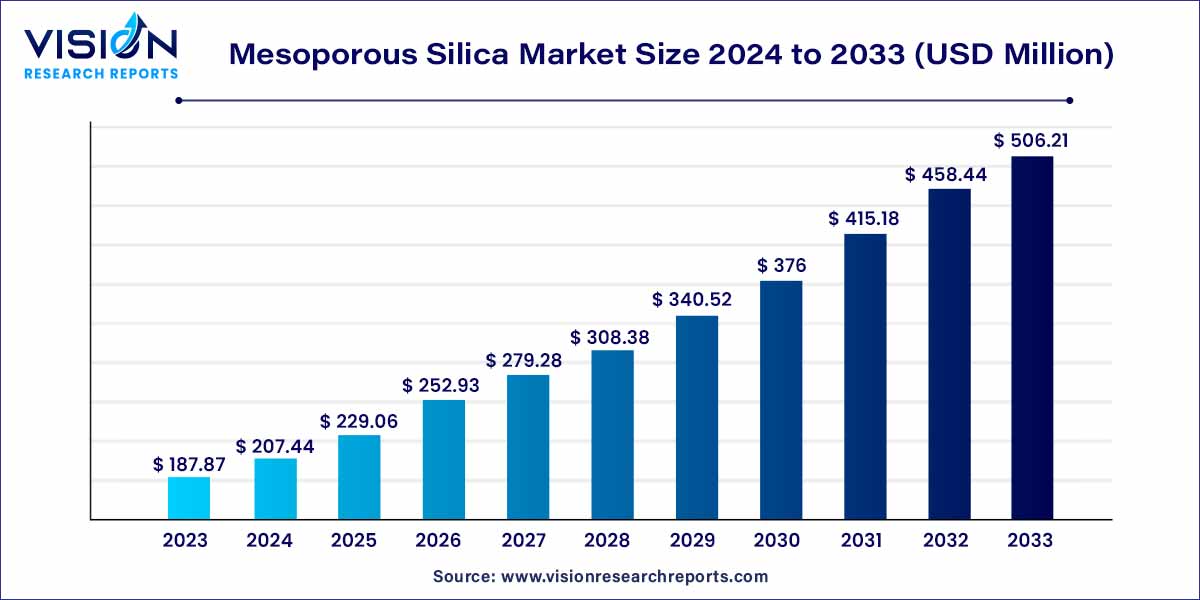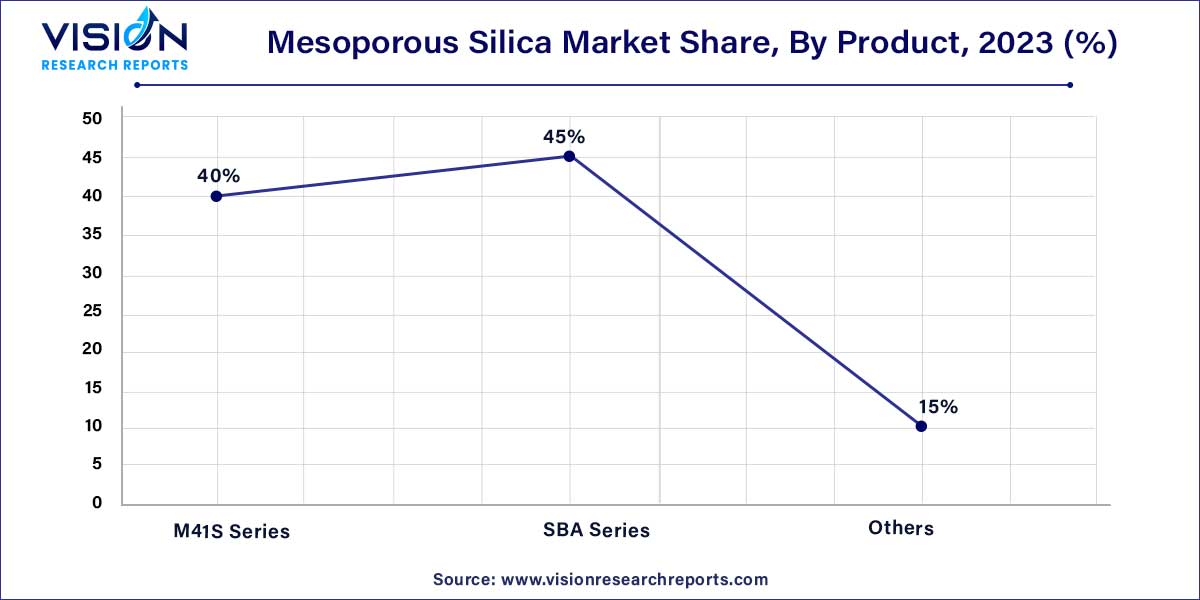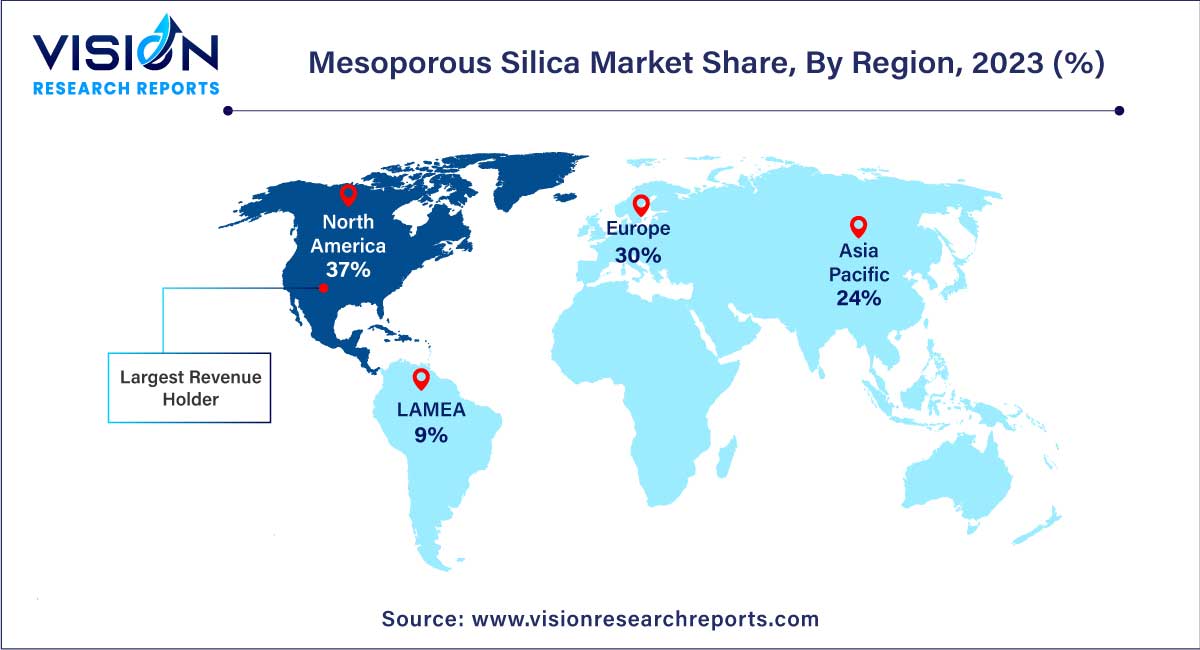The global mesoporous silica market was estimated at USD 187.87 million in 2023 and it is expected to surpass around USD 506.21 million by 2033, poised to grow at a CAGR of 10.42% from 2024 to 2033. The mesoporous silica market is driven by an integration of mesoporous silica in nanotechnology applications, growing investments in research and development activities, enhanced materials in electronics, and demand in pharmaceuticals.

In recent years, the global mesoporous silica market has witnessed significant growth, driven by a myriad of factors such as increasing demand from diverse industries, technological advancements, and a rising emphasis on sustainable materials. This overview aims to provide a comprehensive analysis of the current state of the mesoporous silica market, highlighting key trends, market drivers, challenges, and future prospects.
The mesoporous silica market is experiencing robust growth driven by a confluence of factors. One primary growth factor is the increasing demand across various industries, including pharmaceuticals, electronics, and cosmetics. Mesoporous silica's exceptional surface area and tunable pore size make it an attractive choice for applications such as drug delivery and catalysis. Moreover, the market benefits from ongoing technological advancements that enhance the synthesis methods, enabling the production of mesoporous materials with precise characteristics. Additionally, the global emphasis on sustainable and eco-friendly materials amplifies the market's expansion, as mesoporous silica finds applications in environmentally conscious manufacturing processes. Overall, a combination of versatile applications, technological innovations, and a focus on sustainability propels the mesoporous silica market's growth trajectory.
| Report Coverage | Details |
| Market Revenue by 2033 | USD 506.21 million |
| Growth Rate from 2024 to 2033 | CAGR of 10.42% |
| Revenue Share of North America in 2023 | 37% |
| CAGR of Asia Pacific from 2024 to 2033 | 11.52% |
| Base Year | 2023 |
| Forecast Period | 2024 to 2033 |
| Market Analysis (Terms Used) | Value (US$ Million/Billion) or (Volume/Units) |
The SBA series segment held the largest share of revenue at 45% in 2023 and is anticipated to exhibit the highest Compound Annual Growth Rate (CAGR) of 11.53% throughout the forecast period. The demand for SBA series products is propelled by their advantageous characteristics, including thermal and mechanical stability, high surface area, and ease of functionalization. The SBA category encompasses materials like SBA 15 and SBA 16, which showcase hexagonal and lamellar structures, respectively. SBA mesoporous silica materials feature a meticulously organized pore structure with a broad range of pore sizes and a substantial surface area, rendering them suitable for diverse applications across pharmaceuticals, cosmetics, catalysis, and nanotechnology industries.

The MCM series materials, which include MCM-41 and MCM-48, represent a class of mesoporous silica materials that have gained notable applications across various industries. These materials exhibit well-defined pore structures with sizes ranging from 2 to 10 nanometers, showcasing diverse mesostructures like cubic, hexagonal, and lamellar arrangements. These characteristics contribute to their versatility, making them highly sought-after in both scientific and industrial applications.
Ordered mesoporous silica finds extensive use in diverse applications such as adsorption, drug delivery, separations, and catalysis. Its heightened demand stems from a combination of distinctive features, including a high surface area, well-structured pore arrangements, and favorable thermal, chemical, and mechanical properties.
The drug delivery segment claimed the largest revenue share, accounting for 43% in the global market in 2023. This dominance is attributed to the escalating demand for mesoporous silica materials within the pharmaceutical industry. Furthermore, the ongoing rapid advancements in mesoporous materials are anticipated to significantly broaden their application scope in drug delivery, further fueling the demand for these products.
Conversely, the other applications segment is projected to experience the fastest CAGR of 12.9% throughout the forecast period. The larger surface area and porosity of this silica make it well-suited for the absorption and storage of gases. The distinctive properties of mesoporous silica, coupled with the ability to customize its structure for specific applications, establish it as a versatile and invaluable material across various industries and research domains.
North America dominated the market, holding a significant revenue share of 37% in 2023. This leadership can be attributed to the rapid expansion of the pharmaceutical industry and a notable increase in expenditures on wastewater treatment within the region. The swift pace of industrialization, coupled with growing environmental concerns and strict regulatory measures imposed by regional governments to uphold environmental quality, is expected to drive the adoption of wastewater treatment processes. Consequently, this is likely to propel the utilization of mesoporous silica throughout the forecast period.

An upsurge in investments in the research and development of mesoporous silica, aimed at exploring potential products and applications across various end-use industries, is anticipated. Additionally, the increased incorporation of nanotechnology in biomedical and other applications is poised to contribute significantly to market growth in the region during the projection period.
In contrast, Asia Pacific is projected to exhibit the fastest CAGR of 11.52% throughout the forecast period. The region's rapid industrialization and development, particularly in sectors like automotive and electronics, have generated a heightened demand for mesoporous silica. Given its capacity for innovation and application in diverse fields, mesoporous silica has attracted considerable interest from both researchers and industries in the region. Moreover, the rising prominence of environmental regulations focusing on sustainability, green technologies, and energy-efficient solutions in Asia Pacific is expected to further drive the adoption of mesoporous silica products.
By Product
By Application
By Region
Chapter 1. Introduction
1.1. Research Objective
1.2. Scope of the Study
1.3. Definition
Chapter 2. Research Methodology
2.1. Research Approach
2.2. Data Sources
2.3. Assumptions & Limitations
Chapter 3. Executive Summary
3.1. Market Snapshot
Chapter 4. Market Variables and Scope
4.1. Introduction
4.2. Market Classification and Scope
4.3. Industry Value Chain Analysis
4.3.1. Raw Material Procurement Analysis
4.3.2. Sales and Distribution Channel Analysis
4.3.3. Downstream Buyer Analysis
Chapter 5. COVID 19 Impact on Mesoporous Silica Market
5.1. COVID-19 Landscape: Mesoporous Silica Industry Impact
5.2. COVID 19 - Impact Assessment for the Industry
5.3. COVID 19 Impact: Global Major Government Policy
5.4. Market Trends and Opportunities in the COVID-19 Landscape
Chapter 6. Market Dynamics Analysis and Trends
6.1. Market Dynamics
6.1.1. Market Drivers
6.1.2. Market Restraints
6.1.3. Market Opportunities
6.2. Porter’s Five Forces Analysis
6.2.1. Bargaining power of suppliers
6.2.2. Bargaining power of buyers
6.2.3. Threat of substitute
6.2.4. Threat of new entrants
6.2.5. Degree of competition
Chapter 7. Competitive Landscape
7.1.1. Company Market Share/Positioning Analysis
7.1.2. Key Strategies Adopted by Players
7.1.3. Vendor Landscape
7.1.3.1. List of Suppliers
7.1.3.2. List of Buyers
Chapter 8. Global Mesoporous Silica Market, By Product
8.1. Mesoporous Silica Market, by Product, 2024-2033
8.1.1. M41S Series
8.1.1.1. Market Revenue and Forecast (2021-2033)
8.1.2. SBA Series
8.1.2.1. Market Revenue and Forecast (2021-2033)
8.1.3. Others
8.1.3.1. Market Revenue and Forecast (2021-2033)
Chapter 9. Global Mesoporous Silica Market, By Application
9.1. Mesoporous Silica Market, by Application, 2024-2033
9.1.1. Catalysts
9.1.1.1. Market Revenue and Forecast (2021-2033)
9.1.2. Drug Delivery
9.1.2.1. Market Revenue and Forecast (2021-2033)
9.1.3. Environmental Protection
9.1.3.1. Market Revenue and Forecast (2021-2033)
9.1.4. Others
9.1.4.1. Market Revenue and Forecast (2021-2033)
Chapter 10. Global Mesoporous Silica Market, Regional Estimates and Trend Forecast
10.1. North America
10.1.1. Market Revenue and Forecast, by Product (2021-2033)
10.1.2. Market Revenue and Forecast, by Application (2021-2033)
10.1.3. U.S.
10.1.3.1. Market Revenue and Forecast, by Product (2021-2033)
10.1.3.2. Market Revenue and Forecast, by Application (2021-2033)
10.1.4. Rest of North America
10.1.4.1. Market Revenue and Forecast, by Product (2021-2033)
10.1.4.2. Market Revenue and Forecast, by Application (2021-2033)
10.2. Europe
10.2.1. Market Revenue and Forecast, by Product (2021-2033)
10.2.2. Market Revenue and Forecast, by Application (2021-2033)
10.2.3. UK
10.2.3.1. Market Revenue and Forecast, by Product (2021-2033)
10.2.3.2. Market Revenue and Forecast, by Application (2021-2033)
10.2.4. Germany
10.2.4.1. Market Revenue and Forecast, by Product (2021-2033)
10.2.4.2. Market Revenue and Forecast, by Application (2021-2033)
10.2.5. France
10.2.5.1. Market Revenue and Forecast, by Product (2021-2033)
10.2.5.2. Market Revenue and Forecast, by Application (2021-2033)
10.2.6. Rest of Europe
10.2.6.1. Market Revenue and Forecast, by Product (2021-2033)
10.2.6.2. Market Revenue and Forecast, by Application (2021-2033)
10.3. APAC
10.3.1. Market Revenue and Forecast, by Product (2021-2033)
10.3.2. Market Revenue and Forecast, by Application (2021-2033)
10.3.3. India
10.3.3.1. Market Revenue and Forecast, by Product (2021-2033)
10.3.3.2. Market Revenue and Forecast, by Application (2021-2033)
10.3.4. China
10.3.4.1. Market Revenue and Forecast, by Product (2021-2033)
10.3.4.2. Market Revenue and Forecast, by Application (2021-2033)
10.3.5. Japan
10.3.5.1. Market Revenue and Forecast, by Product (2021-2033)
10.3.5.2. Market Revenue and Forecast, by Application (2021-2033)
10.3.6. Rest of APAC
10.3.6.1. Market Revenue and Forecast, by Product (2021-2033)
10.3.6.2. Market Revenue and Forecast, by Application (2021-2033)
10.4. MEA
10.4.1. Market Revenue and Forecast, by Product (2021-2033)
10.4.2. Market Revenue and Forecast, by Application (2021-2033)
10.4.3. GCC
10.4.3.1. Market Revenue and Forecast, by Product (2021-2033)
10.4.3.2. Market Revenue and Forecast, by Application (2021-2033)
10.4.4. North Africa
10.4.4.1. Market Revenue and Forecast, by Product (2021-2033)
10.4.4.2. Market Revenue and Forecast, by Application (2021-2033)
10.4.5. South Africa
10.4.5.1. Market Revenue and Forecast, by Product (2021-2033)
10.4.5.2. Market Revenue and Forecast, by Application (2021-2033)
10.4.6. Rest of MEA
10.4.6.1. Market Revenue and Forecast, by Product (2021-2033)
10.4.6.2. Market Revenue and Forecast, by Application (2021-2033)
10.5. Latin America
10.5.1. Market Revenue and Forecast, by Product (2021-2033)
10.5.2. Market Revenue and Forecast, by Application (2021-2033)
10.5.3. Brazil
10.5.3.1. Market Revenue and Forecast, by Product (2021-2033)
10.5.3.2. Market Revenue and Forecast, by Application (2021-2033)
10.5.4. Rest of LATAM
10.5.4.1. Market Revenue and Forecast, by Product (2021-2033)
10.5.4.2. Market Revenue and Forecast, by Application (2021-2033)
Chapter 11. Company Profiles
11.1. Merck KGaA
11.1.1. Company Overview
11.1.2. Product Offerings
11.1.3. Financial Performance
11.1.4. Recent Initiatives
11.2. American Elements
11.2.1. Company Overview
11.2.2. Product Offerings
11.2.3. Financial Performance
11.2.4. Recent Initiatives
11.3. nanoComposix, Inc.
11.3.1. Company Overview
11.3.2. Product Offerings
11.3.3. Financial Performance
11.3.4. Recent Initiatives
11.4. Taiyo International
11.4.1. Company Overview
11.4.2. Product Offerings
11.4.3. Financial Performance
11.4.4. LTE Scientific
11.5. Mitsubishi Chemical Corporation
11.5.1. Company Overview
11.5.2. Product Offerings
11.5.3. Financial Performance
11.5.4. Recent Initiatives
11.6. MKnano
11.6.1. Company Overview
11.6.2. Product Offerings
11.6.3. Financial Performance
11.6.4. Recent Initiatives
11.7. W.R. Grace & Co.
11.7.1. Company Overview
11.7.2. Product Offerings
11.7.3. Financial Performance
11.7.4. Recent Initiatives
11.8. AGC Chemicals Americas, Inc.
11.8.1. Company Overview
11.8.2. Product Offerings
11.8.3. Financial Performance
11.8.4. Recent Initiatives
11.9. Glantreo Ltd.
11.9.1. Company Overview
11.9.2. Product Offerings
11.9.3. Financial Performance
11.9.4. Recent Initiatives
11.10. ACS Material LLC
11.10.1. Company Overview
11.10.2. Product Offerings
11.10.3. Financial Performance
11.10.4. Recent Initiatives
Chapter 12. Research Methodology
12.1. Primary Research
12.2. Secondary Research
12.3. Assumptions
Chapter 13. Appendix
13.1. About Us
13.2. Glossary of Terms
 Cross-segment Market Size and Analysis for
Mentioned Segments
Cross-segment Market Size and Analysis for
Mentioned Segments
 Additional Company Profiles (Upto 5 With No Cost)
Additional Company Profiles (Upto 5 With No Cost)
 Additional Countries (Apart From Mentioned Countries)
Additional Countries (Apart From Mentioned Countries)
 Country/Region-specific Report
Country/Region-specific Report
 Go To Market Strategy
Go To Market Strategy
 Region Specific Market Dynamics
Region Specific Market Dynamics Region Level Market Share
Region Level Market Share Import Export Analysis
Import Export Analysis Production Analysis
Production Analysis Others
Others